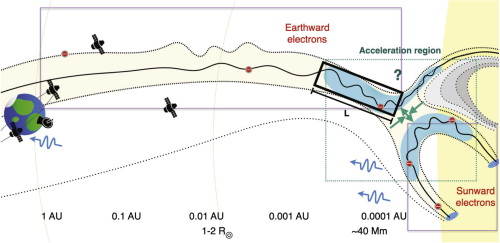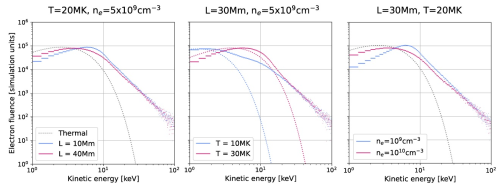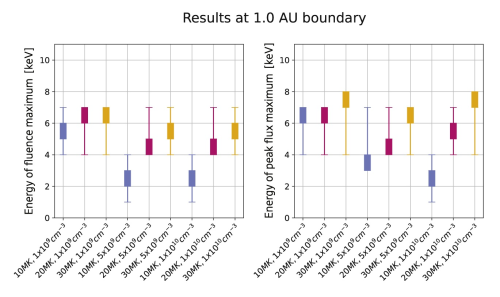Simulated heliospheric electron spectra show sensitivity to plasma properties of a source region in the flaring corona
| Nugget | |
|---|---|
| Number: | 474 |
| 1st Author: | Ross PALLISTER |
| 2nd Author: | Natasha JEFFREY |
| Published: | |
| Next Nugget: | TBD |
| Previous Nugget: | An extremely complex active region with very strong non-neutralized electric currents |
Introduction
The High-energy particles responsible for space weather events at the Earth are known to be accelerated in the corona, the uppermost region of the Sun's atmosphere (e.g. Ref. [1]). We term these "SEPs" (Solar Energetic Particles). In the corona we observe hot and diffuse structures (seen mainly, of course, in 2D projection) that tend to obscure the geometry of the acceleration process(es). Understanding the mechanisms behind the acceleration of solar energetic particles is crucial to predicting space weather events and mitigating their effects on ground-based electric infrastructure as well as near-Earth satellites. The acceleration mechanisms involved are likely to be highly dependent on the specific source location(s) in the corona where the high-energy particles originate.
The presence of high-energy particle acceleration is evident from two main sources: observations of X-rays in the lower regions of the solar atmosphere (the chromosphere) and direct detection in the space between the Sun and the Earth (the heliosphere) using modern spacecraft such as the Parker Solar Probe and Solar Orbiter. The energy spectra of chromospheric X-rays and heliospheric electrons have been shown to correlate (Ref. [2]), suggesting a shared source region for high-energy particles observed during space-weather events. To help determine the environmental properties of the source region, we use numerical simulations to investigate how the heliospheric energy spectra change with respect to these properties, and if these changes can be detected with instruments aboard modern spacecraft at distances close to the Earth.
Simulations
We create a simulation setup containing a variable "acceleration region" within the corona and a heliospheric region extending out to the radius of Earth's orbit, 1 astronomical unit (AU), displayed in Figure 1. A high energy population of electrons is initialised in the acceleration region and subject to decelerating and scattering collisional effects by the ambient plasma. Between simulation runs we vary the length of the acceleration region L, the temperature of the plasma T, and the number density n (the number of ambient electrons per a given volume). The values of the tested properties are consistent with the environment observed during a solar flare. These electrons are then ejected out into our heliospheric region and travel out to 1 AU. We then compare the energy spectra of each simulation at the acceleration region boundary and 1 AU to examine how each tested property affects the resulting spectra [3].

Results
Figure 2 compares electron fluence (time-integrated flux) at the acceleration region boundary subject to varying properties. A larger region L results in the population relaxing to the thermal background spectra (thermalisation) to a greater degree as the electrons are subject to collisional effects over a greater extent. Varying the temperature T changes the thermal background spectra that the population thermalises towards, with colder spectra peaking at lower energies. Finally, increasing the number density n subjects the electrons to a higher rate of collisions, resulting in the spectra thermalising at a faster rate at higher densities.

Our most identifiable metric for determining the effect the ambient plasma has on the initial high-energy electron population is the energy corresponding to the peak of the fluence and flux curves. We calculate these values for the electron spectra at 1 AU at energy resolutions comparable to modern spacecraft instrumentation and plot them in Figure 3.

We see that the energies corresponding to both peak fluence and flux vary according to the temperature of the source acceleration region for sufficiently high densities. This is more recognisable for 1 keV energy resolutions than 3 keV, which can only identify particularly low temperatures.
Conclusions and future work
The energy spectra of simulated heliospheric electrons demonstrate a sensitivity to the plasma properties of a source acceleration region, provided it is a relatively hot and dense region consistent with flaring coronal loops low in the solar corona. This sensitivity should be detectable at energy resolutions that are attainable with current and upcoming datasets from active heliospheric missions. The presence or absence of this sensitivity in real data would help to constrain the location of the solar energetic electron source and further our understanding of the processes behind space weather events.
The model used in this study is currently undergoing expansion, introducing additional acceleration region properties pertaining to turbulent acceleration which has already been shown to play a role in accelerating X-ray emitting electrons (Ref. [4]). By producing heliospheric electron spectra with the same mechanism and properties, we aim to investigate the correlation of both spectra and the feasibility of a shared source region.
References
[2] "Solar flare electron spectra at the Sun and near the Earth"